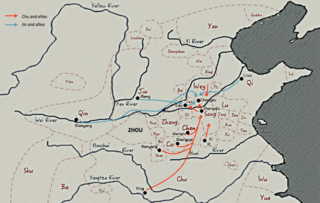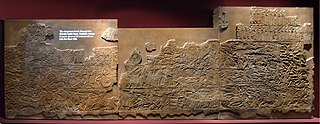 W
WThe Assyrian conquest of Elam refers to the conquest of Elam in western Persia by the Neo-Assyrian Empire. The Elamite lands were finally ravaged beyond repair in 639 BC.
 W
WThe Battle of Carchemish was fought about 605 BC between the armies of Egypt allied with the remnants of the army of the former Assyrian Empire against the armies of Babylonia, allied with the Medes, Persians, and Scythians.
 W
WThe Battle of Chengpu took place in 632 BC between the State of Jin and the State of Chu and its allies during the Spring and Autumn period of Chinese history. It was the first great battle in the protracted conflict between the states of the Yellow River valley, and the states of the Yangtze River valley. The Jin victory confirmed the hegemony of Duke Wen and checked Chu ambitions in the north for at least a generation.
 W
WThe Fall of Ashdod refers to the successful Egyptian assault on the city of Ashdod, one of the five cities of the famed Philistine pentapolis, located in southwestern Canaan, in ca. 635 BC. According to the Greek historian Herodotus, pharaoh Psamtik I, besieged Ashdod for 29 years. Ashdod had lost most of its inhabitants during those long years of siege.
 W
WThe Jewish–Babylonian war was a military conflict between the Kingdom of Judah and Neo-Babylonian Empire that lasted from 601 to 586 BCE. The conflict marked the end of the Kingdom of Judah and a prolonged hiatus in Jewish independence until the Hasmonean revolt in the second century BCE. After Babylonia invaded Jerusalem it destroyed the First Temple, and started the Babylonian exile.
 W
WThe Battle of Loulin was fought in Winter 645 BC between the states of Chu and Xu, the latter being supported by a coalition of northern states led by Qi. Xu, originally the most powerful state of the Huai River valley, had been weakened by internal unrest and several wars since the beginning of the Spring and Autumn period. As its influence over eastern Hubei, southern Henan and central Anhui waned, Chu began to expand into these regions. Threatened by these developments, Xu joined an alliance of several northern states against Chu. In spring 645 BC, when Chu invaded Xu's southern heartland, the northern states sent a relief expedition in order to aid Xu and stop Chu's eastern conquests. The coalition forces eventually met Chu's army at Loulin and were defeated, marking the beginning of Xu's final decline and accelerating the end of Qi's hegemony over China.
 W
WThe Medo-Babylonian conquest of the Assyrian Empire was the last war fought by the Neo-Assyrian Empire between 626 and 609 BC. Succeeding his brother Ashur-etil-ilani, the new king of Assyria, Sinsharishkun, was immediately faced by the revolt of one of his brother's chief generals, Sin-shumu-lishir, who attempted to usurp the throne for himself. Though this threat was dealt with relatively quickly, the instability caused by the brief civil war may have made it possible for another general, Nabopolassar, to rise up and seize power in Babylonia. Sinsharishkun's inability to defeat Nabopolassar, despite repeated attempts over the course of several years, allowed Nabopolassar to consolidate power and form the Neo-Babylonian Empire, restoring Babylonian independence after more than a century of Assyrian rule. The Neo-Babylonian Empire, and the newly formed Median Empire under King Cyaxares, then invaded the Assyrian heartland. In 614, the Medes captured and sacked Assur, the ceremonial and religious heart of the Assyrian Empire, and in 612 their combined armies attacked and razed Nineveh, the Assyrian capital. Sinsharishkun's fate is unknown but it is assumed that he died in the defense of his capital. He was succeeded as king only by Ashur-uballit II, possibly his son, who rallied what remained of the Assyrian army at the city of Harran and, bolstered by an alliance with Egypt, ruled for three years, in a last attempt to resist the Medo-Babylonian invasion of his realm.
 W
WThe Battle of Nineveh is conventionally dated between 613 and 611 BC, with 612 BC being the most supported date. Rebelling against the Assyrians, an allied army which combined the forces of Medes and the Babylonians, besieged Nineveh and sacked 750 hectares of what was, at that time, the greatest city in the world. The fall of Nineveh led to the destruction of the Neo-Assyrian Empire over the next three years as the dominant state in the Ancient Near East. Archeological records show that the capital of the once mighty Assyrian Empire was extensively de-urbanized and depopulated in the decades and centuries following the battle. A garbled account of the fall of the city later led to the story of the legendary king Sardanapalus.
 W
WThe Revolt of Babylon in 626 BC refers to the revolt of the general Nabopolassar and his war of independence until he successfully consolidated control of Babylonia in 620 BC, defeating the Neo-Assyrian Empire which had ruled Babylonia for more than a century. The revolt saw the formation of the Neo-Babylonian Empire and was one of the key factors contributing to the fall of Assyria; twenty years after the revolt had begun, Nabopolassar's army and that of his ally, Cyaxares of the Medes, had destroyed the Neo-Assyrian Empire.
 W
WThe Sack of Thebes took place in 663 BC in the city of Thebes at the hands of the Neo-Assyrian Empire under king Ashurbanipal, then at war with the Kushite Twenty-fifth Dynasty of Egypt under Tantamani, during the Assyrian conquest of Egypt. After a long struggle for the control of the Levant which had started in 705 BC, the Kushites had gradually lost control of Lower Egypt and, by 665 BC, their territory was reduced to Upper Egypt and Nubia. Helped by the unreliable vassals of the Assyrians in the Nile Delta region, Tantamani briefly regained Memphis in 663 BC, killing Necho I of Sais in the process.
 W
WThe Siege of Babylon took place after Assyrian king Sennacherib's victory over the Elamites at the Battle of River Diyala. Although the Assyrians had suffered heavy casualties at the river, they had beaten the Elamites such that the Babylonians now stood alone.
 W
WThe Battle of Susa was a battle involving Assyrians and Elamites. The Assyrian king Ashurbanipal, had grown tired of the Elamites' attacks on the Mesopotamians, and he decided to destroy Susa as punishment.
 W
WThe Battle of the Ulai River, also known as the Battle of Til-Tuba or the Battle of Tulliz, in c. 653 BCE, was a battle between the invading Assyrians, under their king Ashurbanipal, and the kingdom of Elam, which was a Babylonian ally. The result was a decisive Assyrian victory. Teumman, the king of Elam, and his son Tammaritu were killed in the battle.